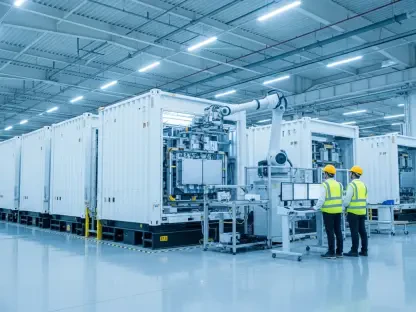As urban areas grapple with increasing demands for sustainable energy solutions, the LIAM F1 UWT wind turbine from the Netherlands emerges as an innovative and timely invention. Renowned for its historical windmills, the Netherlands is now pioneering modern renewable technologies aimed at mitigating pollution and decarbonizing the economy. Amid these advancements, the LIAM F1 UWT stands out as a compact, efficient, and quiet wind turbine, specifically designed for urban applications. Capable of generating between 300 and 2500 kWh annually, it promises to meet approximately half of the energy needs of an average household, marking a significant shift towards localized energy solutions.
One of the most remarkable aspects of the LIAM F1 UWT is its shift from conventional large-scale wind projects to smaller, urban-friendly alternatives. Traditional wind turbines, effective yet demanding vast tracts of land, often pose environmental challenges—intensifying the push for more efficient, space-conserving options. The LIAM F1 UWT, with its helical design inspired by Archimedes’ Spiral, captures wind from multiple directions, maximizing energy output even at low wind speeds. Generating around 1500 kWh per year under minimal conditions, it sets a new standard for urban wind energy devices, balancing function and form seamlessly.
Revolutionizing Urban Renewable Energy
The LIAM F1 UWT encapsulates the future of urban renewable energy by addressing the environmental and logistical limitations of traditional wind turbines. Its smaller footprint and quieter operation make it ideal for rooftop installations, replacing the need for large parcels of land characteristic of conventional turbines. Moreover, its capacity to generate significant energy with minimal wind allows for more widespread adoption in diverse urban settings—ranging from residential buildings to commercial spaces. This turbine aims to bridge the gap between large-scale wind farms and the practical energy needs of urban locales, presenting a versatile solution applicable in various scenarios.
Another critical aspect of the LIAM F1 UWT is its potential synergy with other renewable energy sources, primarily solar power. By integrating photovoltaic systems and energy storage, this wind turbine can optimize the use of renewable resources, significantly reducing reliance on grid electricity. The progressive vision here is to create an energy ecosystem where wind and solar complement each other, harnessing the best of both technologies to deliver consistent, sustainable power. This holistic approach not only maximizes efficiency but also holds the promise of surpassing today’s energy demands while reducing CO2 emissions—crucial for combating climate change.
The rise of innovations such as the LIAM F1 UWT aligns well with the European Union’s broader efforts to pioneer renewable energy solutions. Across Europe, investments in renewable technology are fostering environments where excess production from solar panels augments wind energy, resulting in historically low electricity consumption levels. These concerted efforts underscore a regional commitment to integrating multiple renewable sources, creating a resilient and sustainable energy grid. The success of the LIAM F1 UWT in these settings can serve as a model, encouraging other regions to adopt similar technologically advanced solutions for urban energy challenges.
Environmental and Economic Benefits
Embracing the LIAM F1 UWT for urban energy needs brings forth sweeping environmental and economic advantages. Environmentally, the adoption of such compact and efficient turbines could drive substantial reductions in urban carbon footprints. With conventional energy sources dominating urban landscapes, transitioning to wind and other renewable energy forms can significantly cut greenhouse gas emissions. Moreover, the quieter operation and lower spatial requirements minimize the ecological disruptions often associated with large, traditional wind turbines—rendering them more suitable for densely populated areas where space and noise are prime concerns.
Economically, the LIAM F1 UWT promises substantial savings over time by reducing dependence on grid electricity and fossil fuels. The ability to generate a significant portion of household electricity can lead to lower utility bills, providing an immediate economic benefit to consumers. Additionally, technological advancements in materials and manufacturing processes for these turbines have driven down costs, making them more accessible to a broader audience. In the long run, the widespread adoption of such technologies can stimulate green job creation, bolstering local economies and fostering a more sustainable job market.
The move towards smaller, more efficient wind turbines like the LIAM F1 UWT also reflects a broader trend in energy independence and decentralization. By enabling homes and businesses to produce their own power, dependence on centralized power grids and non-renewable energy sources diminishes. This shift not only provides individual economic benefits but also contributes to the resilience and stability of the overall energy system. Local energy production can mitigate the impacts of grid disruptions and ensure a more reliable supply chain, enhancing urban communities’ adaptability to future energy demands and challenges.
A Vision for the Future
As cities face growing demands for sustainable energy, the LIAM F1 UWT wind turbine from the Netherlands is an innovative solution. Famous for its historic windmills, the Netherlands is now at the forefront of modern renewable energy, focusing on reducing pollution and carbon emissions. The LIAM F1 UWT shines as a compact, efficient, and quiet option tailored for urban environments. With an annual energy generation of 300 to 2500 kWh, it can supply about half the electricity needs of an average household, indicating a significant move towards localized energy sources.
What sets the LIAM F1 UWT apart is its departure from large-scale wind projects to smaller, city-friendly options. Traditional wind turbines are effective but require large areas of land and can have environmental downsides. The LIAM F1 UWT, however, is designed with a helical shape inspired by Archimedes’ Spiral, allowing it to capture wind from various directions and maximize energy production even at lower wind speeds. Producing around 1500 kWh annually under minimal conditions, it establishes a new benchmark for urban wind energy solutions by perfectly balancing functionality and aesthetics.









